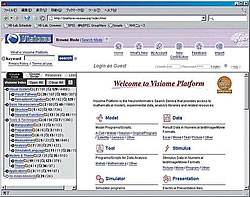Research on the "Neuroinformatics of the Visual System," a five-year cutting edge project funded by the Ministry of Education, Culture, Sports, Science and Technology, finished in March 2004. Neuroinformatics is an emerging field in brain science that merges neuroscience and information science to develop new ways to represent of the structure and function of the brain. These efforts will enable better diagnosis and treatment of encephalopathy, contribute to developing new methods for diagnosis and treatment, and lead to the creation of new information technology. Our work, for example, has contributed significantly to the advances in research on the physiology, higher level functions, and cognition of the vision system. On the technological side, advancements in human like robotics and mathematical modeling have become possible by integrating knowledge from visual science research at every level of their development.
The first ten-year term of the United States NIH sponsored "Human Brain Project: Neuroinformatics Initiative" has also ended and the second term: "A Decade of Neurosicence Informatics" started this April. Furthermore, a mandatory disclosure of experiment data from all projects receiving grants of more than $500,000 was proposed in October last year, which led to the establishment of the Neuroscience Database Gateway (http://big.sfn.org/ndg/site/) by the Society for Neuroscience. In Europe, efforts to promote brain science and gather the accumulating data from around the world are also being made by several countries. Political motivations aside, more and more countries are realizing that further advancement in brain research and continued research promotion requires accessible information houses where researchers can share such relevant data efficiently and effectively.
Thererfore, at a minister-level conference of OECD Science and Technology Committee it was decided that an integrated database system to promote sharing and use of data concerning the brain research be built and that an organization to manage this project be established early next year called the International Neuroinformatics Coordinating Facility, INCF.
The Life Science Committee of Council for Science and Technology of MEXT (Ministry of Education, Culture, Sports, Science and Technology) examined the OECD's request for international cooperation to determine how Japan could systematize and structure its efforts to share its research findings with the world. They recommended establishing a Neuroinfomatics database system that would be come the international standard. Since the Neuroinformatics basis of the visual system: Visiome Platform (Visio+ome, Fig. 1), was already established as part of the earlier project, it has become the prototype for other Neuroinformatics databases. To this end, the "Neuroinformatics Council", whose members are experts in this field, are now developing a public trial of a database system that uses the Visiome Platform as its core. If accepted, it will be the first step in the IT strategic development of Japan's brain science efforts.
BSI's participation in establishing this Bio/Neuro-Informatics Platform is essential to help extend our findings to the public via the internet in the future, and the understanding and cooperation of each member of BSI is vital to this success. To this end, preparations for making the Visiome Platform public are nearly complete,  http://platform.visiome.org, and your advice and comments are eagerly sought.
http://platform.visiome.org, and your advice and comments are eagerly sought.







